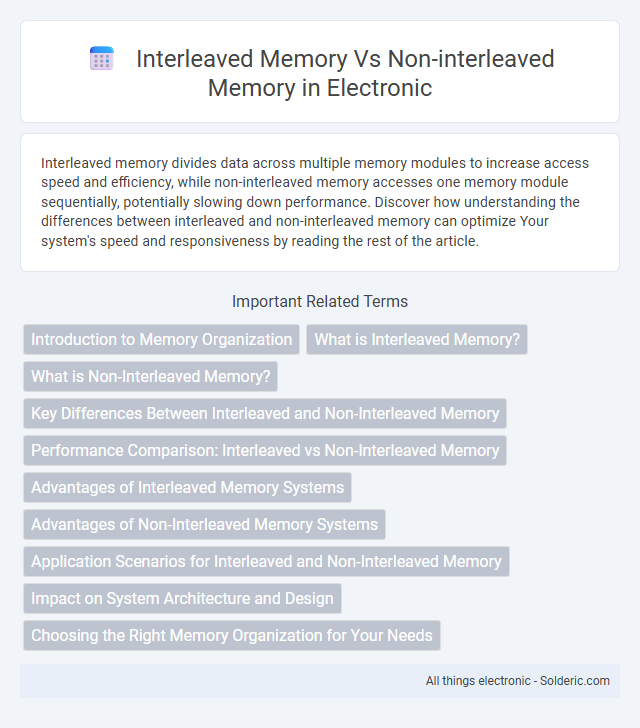Interleaved memory divides data across multiple memory modules to increase access speed and efficiency, while non-interleaved memory accesses one memory module sequentially, potentially slowing down performance. Discover how understanding the differences between interleaved and non-interleaved memory can optimize Your system's speed and responsiveness by reading the rest of the article.
Comparison Table
| Feature | Interleaved Memory | Non-Interleaved Memory |
|---|---|---|
| Memory Organization | Memory divided into multiple banks accessed in parallel | Memory accessed sequentially, one bank at a time |
| Access Speed | Higher speed due to parallel access and reduced wait time | Slower speed due to serial access and longer wait cycles |
| Latency | Lower latency, improved throughput | Higher latency, limited throughput |
| Complexity | More complex hardware design with bank management | Simpler hardware setup |
| Use Cases | High-performance computing, cache memory systems | Standard memory systems with simple requirements |
| Cost | Higher due to additional control circuits | Lower cost and simpler implementation |
Introduction to Memory Organization
Interleaved memory organizes RAM into multiple modules accessed sequentially to enhance data transfer rates and reduce latency by allowing parallel access to memory addresses. Non-interleaved memory accesses each memory location one at a time, often resulting in slower data throughput due to the inability to overlap memory operations. Efficient memory organization in interleaved systems improves CPU performance by maximizing bandwidth and minimizing wait states during memory access.
What is Interleaved Memory?
Interleaved memory is a technique used in computer architecture to increase memory access speed by spreading memory addresses evenly across multiple memory modules or banks. This allows your system to read from or write to different memory banks simultaneously, reducing wait times and improving overall performance. Non-interleaved memory accesses one memory module at a time, which can create bottlenecks and slower data retrieval compared to the parallel access offered by interleaved memory.
What is Non-Interleaved Memory?
Non-interleaved memory refers to a memory system where data is stored and accessed sequentially in a single continuous block without distributing addresses across multiple memory modules. This configuration can lead to slower access times and reduced bandwidth because only one memory module is active at a time. Non-interleaved memory contrasts with interleaved memory, which splits data evenly across multiple modules to enhance parallelism and increase throughput.
Key Differences Between Interleaved and Non-Interleaved Memory
Interleaved memory enhances system performance by splitting memory addresses across multiple memory modules, allowing simultaneous access and reducing latency, whereas non-interleaved memory accesses one memory module at a time, leading to slower data retrieval. Interleaved memory optimizes bandwidth and speeds up processing tasks in high-performance computing environments, while non-interleaved memory is simpler and often used in systems with limited memory demands. Understanding these key differences helps you select the appropriate memory type for balancing cost, complexity, and performance needs.
Performance Comparison: Interleaved vs Non-Interleaved Memory
Interleaved memory significantly improves performance by allowing simultaneous access to multiple memory modules, reducing wait times and increasing data throughput compared to non-interleaved memory, which accesses one module at a time sequentially. This parallel access in interleaved memory enhances CPU efficiency and speeds up memory-intensive operations, particularly in multi-core processor environments. Non-interleaved memory, while simpler to implement, often results in higher latency and slower overall system performance under heavy workloads.
Advantages of Interleaved Memory Systems
Interleaved memory systems enhance performance by allowing simultaneous access to multiple memory modules, reducing wait times and increasing overall data throughput. This architecture efficiently balances memory bandwidth and latency, leading to faster processing speeds in multi-core and high-demand computing environments. Your system benefits from improved resource utilization and smoother data flow, making interleaved memory ideal for intensive applications.
Advantages of Non-Interleaved Memory Systems
Non-interleaved memory systems offer simplified memory management by using a single contiguous address space, which reduces the complexity of address decoding and improves compatibility with legacy software. They provide predictable latency since memory access times are consistent without the overhead of distributing data across multiple banks. This approach minimizes hardware design constraints and can be more cost-effective for systems that do not require high memory bandwidth.
Application Scenarios for Interleaved and Non-Interleaved Memory
Interleaved memory is ideal for high-performance computing environments and parallel processing applications where memory access speed and bandwidth are critical, such as in servers and gaming consoles. Non-interleaved memory suits simpler, cost-sensitive applications like embedded systems and basic consumer electronics, where memory access speed is less critical. Systems requiring low latency for sequential data access benefit more from non-interleaved memory, while workloads demanding high throughput utilize interleaved memory effectively.
Impact on System Architecture and Design
Interleaved memory enhances system architecture by distributing memory addresses evenly across multiple memory modules, improving parallelism and data throughput. Non-interleaved memory places consecutive addresses in a single module, which may simplify design but limits bandwidth and increases latency. Your system design benefits from interleaved memory when aiming for higher performance in multi-core processors and high-speed data access scenarios.
Choosing the Right Memory Organization for Your Needs
Interleaved memory improves system performance by dividing memory into multiple modules accessed simultaneously, reducing latency and increasing bandwidth, ideal for high-demand applications like gaming and scientific computing. Non-interleaved memory features a single continuous memory block, offering simplicity and cost-effectiveness, suitable for general-purpose computing with lower performance requirements. Selecting the right memory organization depends on workload intensity, budget constraints, and the need for speed versus system simplicity.
Interleaved memory vs non-interleaved memory Infographic

 solderic.com
solderic.com